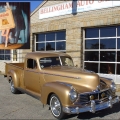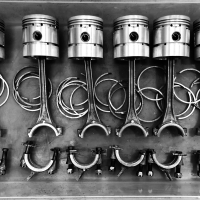Oil Change
Old Fogey UK
Expert Adviser
in HUDSON
I'm about to do a single-handed full oil change on my '34.
Any tips on how to avoid half drowning myself in dirty oil (which usually happens) when I drop the pan and the inner tray ?
0
Comments
-
Remove 4 corner bolts replacing them with lengths of threaded rod with nuts up against the pan. Remove all the other bolts, wind the 4 nuts down the threaded rods.0
-
Use 4 long bolts when reinstalling the pan a tray. Then while it’s hanging you can put a quart of oil in each trough with a funnel and hose and then install the pan.0
-
I used 4 long bolts and squirted 2 quarts of oil into the tray with a large syringe. I tried to distribute it along the whole tray but, inevitably, the tray and pan rocked a bit as I raised it up so the oil in the tray would have run around.
I suppose the safe thing to do would be to spin the engine with the ignition off to redistribute the oil around the tray ?
Even using the 4 long bolts method, this is still a very messy process. Is there any practical way of filling the tray after it and the pan have been installed ?0 -
Wow! I applaud your level of commitment to doing a thorough oil change!
I have never removed the oil pan when changing oil, in 47 years. Sometimes, after draining the oil from the pan, I would hit the starter for a few seconds, and splash some of the "dipper oil" out of the upper trays. But, when I refilled the new oil, there was always a bit of dirty oil left in the dipper trays.
If you're going to remove the pan, one way to prevent drowning yourself in oil (when replacing the pan) would be to set the pan on a hydraulic floor jack (the kind with casters) and raise the pan with the jack, until it's close enough to the block to get some bolts into. I don't own such a jack, but I seem to recall that they keep the "jacked object" level as they raise it.
I've also heard of another alternative for adding oil to the upper trays (after a complete oil pan removal and replacement). I'm told that, if you remove the valve covers from the side of the engine block, you can pour oil into the valve chamber, and the oil will drain down into the dipper tray, from which it then overflows into the main oil pan below. Never tried this, so you'd need to get someone to verify it.
0 -
I won't do it again in a hurry myself, Jon !0
-
Filling through the valve chamber pours the oil onto the dipper tray.
No idea how the factory filled the engines, they would have wanted a quick efficient foolproof method of making sure the dipper tray was full.0 -
I have purchased a 37 Terraplane that hasn't been started in 17 years. I would like to completely change ALL of the engine oil. I'm new to HETCLUB and splasher engines and I will appreciate any advise.
0 -
It's a very messy job but there's some good advice on this discussion thread.0
-
Grateful: Since the car has been stored so long, you should make sure the oil pump, which is located outside of the engine, has not become dry. I suggest that first, you drain the old oil out, without disturbing the upper pan, and put in new oil. This oil will all go to the oil pan (The oil in each trough should still be there. However, if you want, you can follow the instructions above to add some of the oil through the valve covers. If you do this, make sure some new oil goes down each drain hole).
Now make sure the oil light turns on when you turn on the key, but before you start the engine. If the oil light turns on, start the engine, while watching the oil light. If the light turns off within a few seconds, it means that the oil pump is working. If it stays on, turn the engine off immediately. This means the oil pump needs lubrication. In this case, remove the oil pump (both ends of it) and put some oil in. Then try again, and the oil light should turn off quickly, showing the oil is flowing. After running the engine a while, you may want to drain the oil out, and put new oil in.
I once bought a 1946 Super Six which had been stored 30 years. Someone had started it without checking the oil pump. It had two connecting rods which had become loose as a result. I found the inside of the oil pump to be dry. The dry oil pump had not been able to suck oil, so nothing had reached the connecting rods, main bearings or camshaft.
Per0 -
Per ... Thank you for this very useful information. I will be very sure that the oil pressure light is connected.
0 -
grateful, drain the oil and drop the oil pan and clean out the oil sump and the dipper pan. Make sure you put oil in the dipper pan before assembly. This way you can inspect the condition of the engine, lose rods, pieces of rabbit in the oil etc. Under no circumstances should you start up an engine that has been sitting that long without cleaning it out. Just my 2 cents worth.grateful said:I have purchased a 37 Terraplane that hasn't been started in 17 years. I would like to completely change ALL of the engine oil. I'm new to HETCLUB and splasher engines and I will appreciate any advise.0 -
Rabbit in the oil? Check for hares and tortoises as well then.0
-
If from Texas May want to check for that stray Armadillo! ?0
-
hudsonsplasher1 said:
grateful, drain the oil and drop the oil pan and clean out the oil sump and the dipper pan. Make sure you put oil in the dipper pan before assembly. This way you can inspect the condition of the engine, lose rods, pieces of Babbit in the oil etc. Under no circumstances should you start up an engine that has been sitting that long without cleaning it out. Just my 2 cents worth.grateful said:I have purchased a 37 Terraplane that hasn't been started in 17 years. I would like to completely change ALL of the engine oil. I'm new to HETCLUB and splasher engines and I will appreciate any advise.
0
Categories
- 36.6K All Categories
- 85 Hudson 1916 - 1929
- 11 Upcoming Events
- 73 Essex Super 6
- 28.3K HUDSON
- 511 "How To" - Skills, mechanical and other wise
- 989 Street Rods
- 150 American Motors
- 170 The Flathead Forum
- 47 Manuals, etc,.
- 71 Hudson 8
- 40 FORUM - Instructions and Tips on using the forum
- 2.7K CLASSIFIEDS
- 592 Vehicles
- 2.1K Parts & Pieces
- 76 Literature & Memorabilia
- Hudson 1916 - 1929 Yahoo Groups Archived Photos



